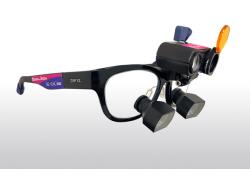- About Us
- Advertise
- Editorial
- Contact Us
- Terms and Conditions
- Privacy Policy
- Do Not Sell My Personal Information
© 2025 MJH Life Sciences™ and Dental Products Report. All rights reserved.
A behind the scenes look at Air Techniques’ Spectra Caries Detection Aid [VIDEO]
We talked with Air Techniques Engineer Manager Dennis Allmer about this caries detection aid and how it can benefit dental practices as well as patients.
We talked with Air Techniques Engineer Manager Dennis Allmer about this caries detection aid and how it can benefit dental practices as well as patients.
Finding and treating caries at an early stage is key to keeping your patients in optimal oral health.
That’s why the team at Air Techniques developed the Spectra Caries Detection Aid-to give dentists an extra tool to help them spot caries earlier, which leads to more conservative treatment and less excavation. Here, Dennis Allmer, who was part of the engineering team, tells how the detection aid was developed and why it’s an important product to have in your practice.
Q: What was the idea behind Spectra?A: One of the main reasons people fear going to the dentist is the prospect of having their teeth drilled.
Our company realized a product capable of discovering dental caries in earlier stages, and thus reducing the need for excavation, would be of tremendous value for both dentists and their patients.
Our engineering team knew autofluorescence technology can help reveal things that might not be apparent to the naked eye.
When thinking about how we might apply this science to dentistry, we realized autofluorescent light would be absorbed differently by different objects on a tooth.
Then, when we saw that caries bacteria has a unique spectral response to autofluorescence, we hit upon the idea of developing a device that emits autofluorescent light and engineering a method of using both colors and numbers to convert responses from that light to a graphic image via live video feedback.
Because we were already leaders in intraoral video imaging, we were able to hit the ground running and develop the Spectra Caries Detection Aid.
Q: What was the development process like?A: Our first generation Spectra was released in 2009. The major challenges associated with this development cycle were extensive: optics, electronics, software, industrial packaging, mechanical design, production test and validation, clinical testing, and time to market.
Knowing there was a great need for this product in the dental community, our senior management allowed our technical development team to pursue all means necessary to ensure the light emission/collection, video capturing, software development, and, in particular, the color and numerical interpretation of spectral responses would meet the clinicians’ needs.
Despite our sense of urgency, the development cycle took years.
The second and current generation Spectra system reflects numerous enhancements based on user feedback we received on the first generation product.
We listen very closely to the voice of the customer, and this enabled us to make many improvements in our industrial design while also aligning visually with the intraoral camera family. Spectra is designed and engineered to be highly intuitive, and despite its ultimate design simplicity, we had to overcome many technical challenges.
Addressing user desires for more ergonomic controls for image capture and image saving probably produced the most technically sensitive challenges.
Dealing with the subtleties of user interaction while creating a design capable of production repeatability required a great deal of intensive technical brainstorming, but the reaction we have received from the dental community shows it was time and effort well spent.
Q: What sets Spectra apart?A: Spectra enables clinicians to not only discover caries at much earlier stages, but to clearly communicate to patients exactly what has been discovered and why treatment is recommended.
Spectra allows the dentist to tour the mouth via live video, evaluating any individual tooth for caries suspicion.
Much like Spectra’s intraoral white light intraoral camera sibling, Polaris, the video is then captured as an image for further study. In Spectra’s case, the extent of any detected decay is represented using both colors and numbers, making clinical interpretation much easier and much less subjective.
The image on the operatory monitor closely resembles Doppler radar, and our users tell us this is quite a “wow factor” for their patients. This not only helps position the practice as being state of the art, it aids in securing case acceptance.
Spectra also enhances the practice’s workflow by virtue of being part of Air Techniques’ camera family line. Spectra and our Polaris intraoral camera are externally constructed from the same platform of housing, button control, and USB interconnection.
The practitioner can change from Polaris to Spectra and back in a few seconds.
Q: What features are you most proud of?A: Spectra is a high performance product, as epitomized by its ability to accurately and reliably repeat fluorescence color and numerical interpretation.
While this is designed to make the dentist’s job of discovery and diagnosis much easier, the underlying engineering that makes this possible was anything but easy.
The rigorous testing we subject every Spectra unit to is a testament to the commitment of our engineering team, led by principal engineer Frank Farbizio, and to our passion for enhancing the success of our customers and the health and comfort of their patients.
Q: How does it improve patient care?A: For decades, tooth decay has been diagnosed by a combination of x-ray radiology and a dental explorer. Spectra provides a whole new level of previously unavailable information that can be used to treat decay at earlier stages.
This allows dentists to practice more conservative dentistry by doing less excavation, or to avoid excavation altogether and instead re-grow tooth structure by remineralization. As a result, patients will be less likely to be afraid of going to the dentist, or the financial pain of costly restorations.
Watch this video to learn how ScanX swift, Polaris Intraoral Camera and Spectra Caries Aid can be used on a single patient:



